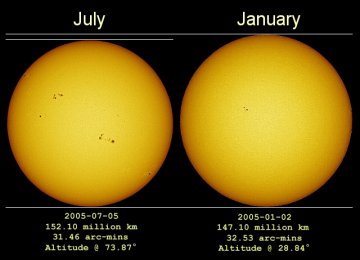 Where's Saturn? Is that a UFO--or the ISS? What's the name of that star? Get the answers from mySKY--a fun new astronomy helper from Meade. Where's Saturn? Is that a UFO--or the ISS? What's the name of that star? Get the answers from mySKY--a fun new astronomy helper from Meade. MARS UPDATE: A late-June dust storm that delayed Mars rover Opportunity's descent into Victoria Crater has intensified and spread around the planet, reports veteran observer Jim Melka of St. Louis, Missouri. On July 6th, the view through Melkin's 12-inch telescope showed "a chain of five dust clouds over Mare Cimmerium," he says. "One cloud is very close to the location of the Opportunity's twin, Spirit." Stay tuned for updates. SOLAR ACTIVITY: "A new active region is announcing itself with a nice eruption," reports Cai-Uso Wohler of Bispingen, Germany, who took this picture just a few hours ago: 
The source of the blast--probably a sunspot just beyond the pictured horizon--is not yet visible, but it soon will be. The sun's rotation is turning the blast site toward Earth. Amateur astronomers with solar telescopes should monitor the eastern limb for developments. more images: from Joel Bavais of Ath, Belgium; from Pavol Rapavy of Rimavska Sobota, Slovakia; from Pete Lawrence of Selsey, West Sussex, UK; from John Stetson of South Portland, Maine. STRANGE BUT TRUE: Sweltering populations in the American west might find this hard to believe: Earth is extra-far from the sun today. On July 7th, Earth passes through a point in its orbit called aphelion, which is 5 million km farther from the sun than the opposite point in January (perihelion). This has many consequences. For one thing, the sun looks a few percent smaller than usual: 
Photo credit: Anthony Ayiomamitis of Athens, Greece.
Also, sunlight falling on Earth is 7% less intense averaged over the globe. Yet the temperature in Las Vegas remains 114 degrees. What's going on? Click here for the answer. more images: from John Stetson of Falmouth, Maine; from Gema Araujo of Merida, Spain
2007 Noctilucent Cloud Gallery
["Noctilucent Cloud"--the song] [Night-Sky Cameras] | 
